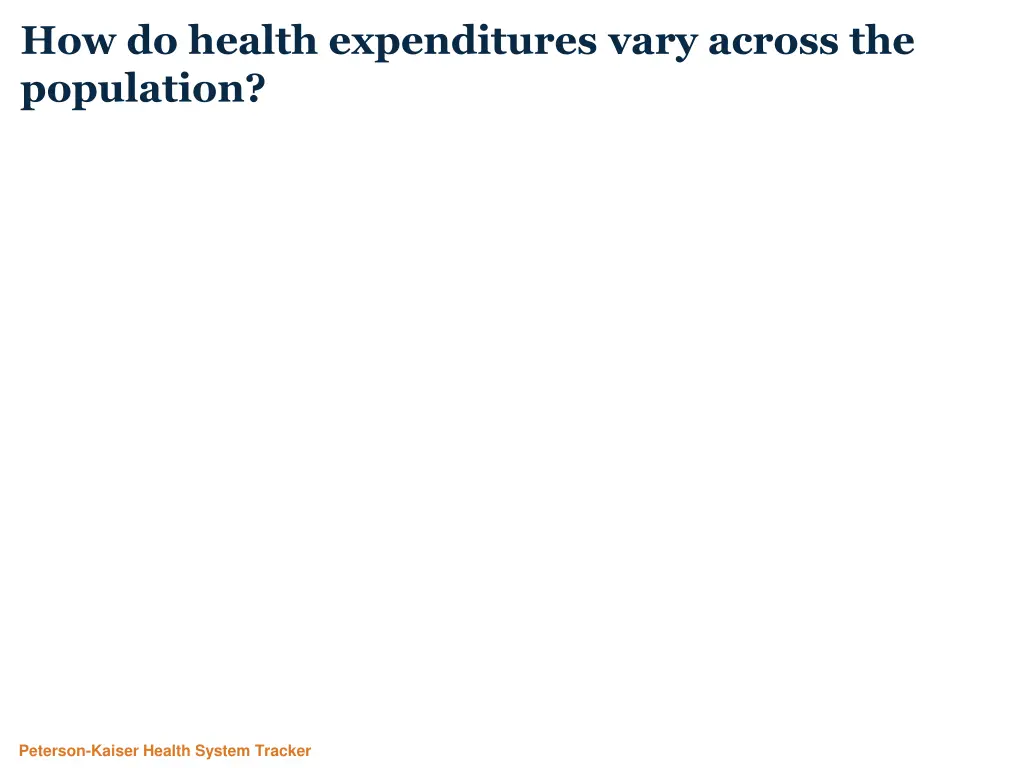
Understanding Health Expenditure Disparities in the Population
Explore the variation in health expenditures across the population through an analysis of the distribution of health spending, out-of-pocket expenses, family spending patterns, reported health status, and concentration of spending among those with fair or poor health. The data highlights the significant disparities in health spending and overall health status within different segments of the population.
Download Presentation

Please find below an Image/Link to download the presentation.
The content on the website is provided AS IS for your information and personal use only. It may not be sold, licensed, or shared on other websites without obtaining consent from the author. If you encounter any issues during the download, it is possible that the publisher has removed the file from their server.
You are allowed to download the files provided on this website for personal or commercial use, subject to the condition that they are used lawfully. All files are the property of their respective owners.
The content on the website is provided AS IS for your information and personal use only. It may not be sold, licensed, or shared on other websites without obtaining consent from the author.
E N D
Presentation Transcript
How do health expenditures vary across the population? Peterson-Kaiser Health System Tracker
Discussion of health spending often focus on averages, but spending varies considerably across the population Contribution to total health expenditures by individuals, 2013 0.97 1.00 0.90 0.82 0.80 0.75 0.70 0.65 0.60 0.49 0.50 0.40 0.21 of total health spending 0.30 0.20 0.10 0.03 0.00 Top 1% of health spenders Top 5% Top 10% Top 15% Top 20% Top 50% Lower 50% Source: Kaiser Family Foundation analysis of Medical Expenditure Panel Survey, Agency for Healthcare Research and Quality, U.S. Department of Health and Human Services Peterson-Kaiser Health System Tracker
Out-of-pocket spending on health services is almost as concentrated as overall health spending Out-of-pocket Spending on Health Services, 2013 98% 100% 90% 79% 80% 72% 70% 61% 60% 50% 45% 40% 30% 20% of OOP spending 20% 10% 2% 0% Top 1% of OOP spenders Top 5% Top 10% Top 15% Top 20% Top 50% Lower 50% Source: Kaiser Family Foundation analysis of Medical Expenditure Panel Survey, Agency for Healthcare Research and Quality, U.S. Department of Health and Human Services Peterson-Kaiser Health System Tracker
Family spending is also very concentrated, with 10% of families accounting for half of spending Contribution to total health spending per family, 2013 100% 93% 90% 80% 70% 70% 61% 60% 51% 50% 40% 35% 30% 14% of total health spending 20% 7% 10% 0% Top 1% of health spender Top 5% Top 10% Top 15% Top 20% Top 50% Lower 50% Source: Kaiser Family Foundation analysis of Medical Expenditure Panel Survey, Agency for Healthcare Research and Quality, U.S. Department of Health and Human Services Peterson-Kaiser Health System Tracker
Most of the population reports being in good or better health Reported Health Status, 2013 35% 33% 32% 30% 24% 25% 20% 15% 10% 8% 5% 3% 0% Excellent Very Good Good Fair Poor Source: Kaiser Family Foundation analysis of Medical Expenditure Panel Survey, Agency for Healthcare Research and Quality, U.S. Department of Health and Human Services Peterson-Kaiser Health System Tracker
Among those reporting fair or poor health, there is considerable concentration of health spending Distribution of health spending among those reporting fair or poor health, 2013 100% 94% 90% 80% 71% 70% 63% 60% 52% 50% 36% 40% 30% 14% of group spending 20% 10% 6% 0% Top 1% of spenders in this group Top 5% Top 10% Top 15% Top 20% Top 50% Lower 50% Source: Kaiser Family Foundation analysis of Medical Expenditure Panel Survey, Agency for Healthcare Research and Quality, U.S. Department of Health and Human Services Peterson-Kaiser Health System Tracker
Considerable spending variation exists among the elderly, who see the highest proportion of health spending overall Distribution of health spending among elderly population (age 65+), 2013 100% 91% 90% 80% 70% 66% 58% 60% 47% 50% 40% 32% 30% 12% of group spending 20% 9% 10% 0% Top 1% of spenders in this group Top 5% Top 10% Top 15% Top 20% Top 50% Lower 50% Source: Kaiser Family Foundation analysis of Medical Expenditure Panel Survey, Agency for Healthcare Research and Quality, U.S. Department of Health and Human Services Peterson-Kaiser Health System Tracker
People age 55 and over account for almost half of total health spending Share of total health spending by age group, 2013 100% 12% of spending (by 25% of population) 90% Under 19 13% (by 22%) 80% 70% 10% (by 13%) 19 to 34 60% 16% ( by 14%) 50% 35 to 44 40% 19% (by 13%) 45 to 54 30% 55 to 64 20% 29% (by 15%) 10% 65 and over 0% Share of Population Share of Spending Source: Kaiser Family Foundation analysis of Medical Expenditure Panel Survey, Agency for Healthcare Research and Quality, U.S. Department of Health and Human Services Peterson-Kaiser Health System Tracker
While health spending increases throughout adulthood for both men and women, spending varies by age Average health spending by age and gender, 2013 Males Females $10,000 $9,908 $9,500 $8,000 $7,151 $7,019 $6,000 $5,625 $4,000 $4,037 $4,033 $3,475 $1,371 $2,747 $2,000 $2,081 $1,947 $0 Under 19 19 to 34* 35 to 44* 45 to 54* 55 to 64 65 and over * Indicates that, for the age range, the difference in estimates for males and females is statistically significant (p<.05) Source: Kaiser Family Foundation analysis of Medical Expenditure Panel Survey, Agency for Healthcare Research and Quality, U.S. Department of Health and Human Services Peterson-Kaiser Health System Tracker
Diagnosis with a serious or chronic health condition is associated with higher spending Per capita health spending based on diagnosis status, in $U.S. Dollars, 2013 Ever been diagnosed Never diagnosed $16,000 $14,868 $14,000 $13,947 $12,913 $12,000 $12,166 $11,516 $10,000 $10,253 $8,742 $8,000 $8,285 $6,733 $6,000 $4,976 $4,773 $4,000 $4,411 $4,349 $4,171 $3,935 $3,740 $3,366 $3,317 $2,000 $0 Stroke Emphysema Diabetes Heart Disease Cancer Arthritis High Blood Pressure High Asthma Cholesterol Source: Kaiser Family Foundation analysis of Medical Expenditure Panel Survey, Agency for Healthcare Research and Quality, U.S. Department of Health and Human Services Note: For all diagnoses shown, with the exception of asthma, diagnosis status was asked only of respondents age 18 or older. All respondents were asked about their asthma diagnosis status. Peterson-Kaiser Health System Tracker
Whites have higher health spending in most age categories than people in other groups Average health spending by age and race/ethnicity, 2013 Asian Hispanic Black White $10,000 $9,949 $9,802 $9,000 $8,000 $7,594 $7,371 $7,000 $7,086 $6,000 $6,160 $5,832 $5,000 $5,132 $5,058 $4,000 $4,222 $4,177 $3,859 $3,670 $3,000 $2,954 $2,857 $1,222 $1,225 $2,528 $2,000 $2,209 $2,125 $1,964 $1,747 $1,636 $1,528 $1,000 $0 * Under 19 * 35 to 44 * * * * * 65 and over * * * * * 19 to 34 * * * 45 to 54 55 to 64 * Indicates that, for the age range, the difference from the average of other racial/ethnic groups is statistically significant (p<.05) Source: Kaiser Family Foundation analysis of Medical Expenditure Panel Survey, Agency for Healthcare Research and Quality, U.S. Department of Health and Human Services Peterson-Kaiser Health System Tracker
People with some insurance have much higher health spending than people who are uninsured all year Average health spending by age and insurance, 2013 Had insurance Uninsured all year $8,000 $7,756 $7,000 $6,000 $5,403 $5,000 $4,000 $3,925 $3,000 $2,976 $2,722 $2,274 $2,000 $2,079 $780 $573 $1,239 $1,000 $0 Under 19* 19 to 34* 35 to 44* 45 to 54* 55 to 64* * Indicates that, for the age range, the difference in estimates for the insured and uninsured is statistically significant (p<.05) Source: Kaiser Family Foundation analysis of Medical Expenditure Panel Survey, Agency for Healthcare Research and Quality, U.S. Department of Health and Human Services Peterson-Kaiser Health System Tracker
A substantial share of the population spends $200 or less out-of-pocket on health care services Average out-of-pocket spending in $US Dollars, 2013 35% 29% 30% 27% 25% 20% 16% 15% 12% 11% 10% 5% 5% 0% $0 >$0 to $200 >$200 to $500 >$500 to >$1000 >$1000 to $2500 >$2500 Source: Kaiser Family Foundation analysis of Medical Expenditure Panel Survey, Agency for Healthcare Research and Quality, U.S. Department of Health and Human Services Peterson-Kaiser Health System Tracker






















